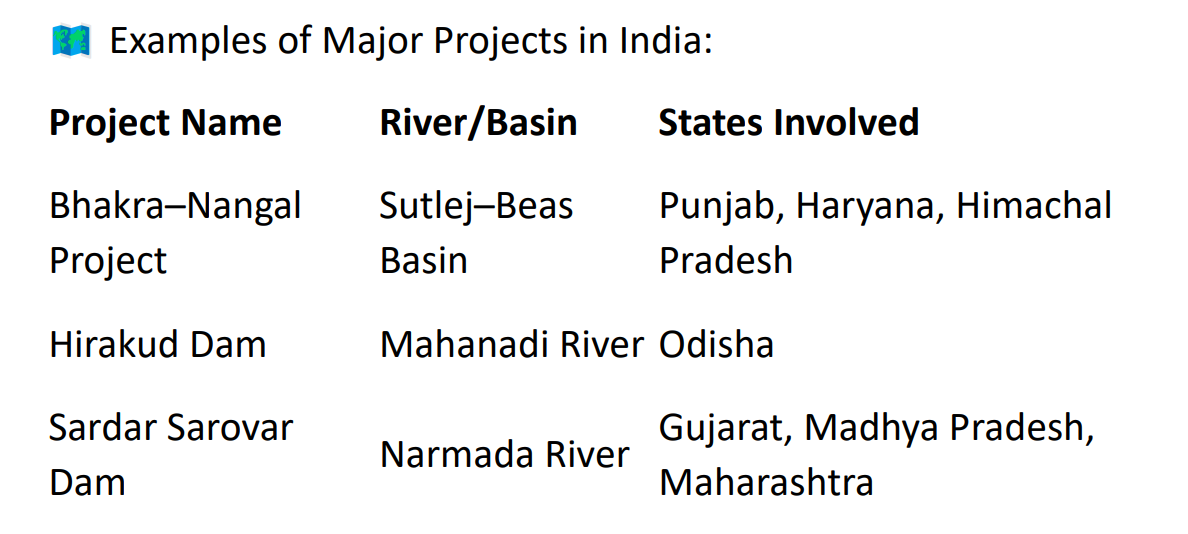Water Resources Chapter 3
Water is a renewable resource, but its availability is uneven across time and space. This chapter explores the distribution, scarcity, conservation methods, and management of water resources in India.
1. Water: Some Facts and Figures
• Earth’s water composition:
- 96.5% in oceans (saline)
- 2.5% as freshwater
- Only 0.3% is usable by humans (surface water and groundwater)
• India’s water statistics:
• Receives ~4% of global precipitation
• Ranks 133rd in water availability per person
• Predicted to face absolute water scarcity in many regions by 2025
2. Water Scarcity and Its Causes
Definition:
Water scarcity refers to the lack of sufficient water to meet the demands of a region.
Causes:
• Over-exploitation of groundwater
• Excessive use in agriculture and industry
• Unequal access among social groups
• Pollution from domestic and industrial waste
• Population growth and urbanization
Water Scarcity and Its Causes – Explained
Definition:
Water scarcity means there is not enough water available to meet the needs of people, agriculture, industry, and the environment in a particular region. It can be due to natural shortages or human-induced factors.
Causes of Water Scarcity:
1. Over-exploitation of Groundwater
• Groundwater is extracted through wells and boreholes for drinking, irrigation, and industrial use.
• In many regions, especially in agricultural belts, groundwater is pumped faster than it can be naturally replenished.
• This leads to falling water tables, drying of wells, and long-term depletion of aquifers
2. Excessive Use in Agriculture and Industry
• Agriculture consumes about 70% of freshwater globally.
• Practices like flood irrigation waste large amounts of water.
• Industries use water for cooling, cleaning, and processing, often without recycling it.
• In water-intensive crops (e.g., sugarcane, paddy), the demand far exceeds sustainable supply.
3. Unequal Access Among Social Groups
• In many areas, wealthier communities or industries have better access to water through private sources.
• Marginalized groups, especially in rural or slum areas, often depend on unreliable public sources.
• This inequality leads to conflicts and social tension, especially during shortages.
4. Pollution from Domestic and Industrial Waste
• Untreated sewage and industrial effluents contaminate rivers, lakes, and groundwater.
• Polluted water becomes unusable for drinking or irrigation.
• This reduces the effective availability of clean water, contributing to scarcity.
5. Population Growth and Urbanization
• Rapid population growth increases the demand for water in households, agriculture, and services.
• Urbanization leads to:
- Increased water consumption
- Loss of natural recharge zones due to concrete surfaces
- Pressure on municipal water systems
• Cities often overdraw water from nearby rivers or aquifers, affecting rural areas.
Real-World Example:
• In cities like Delhi and Bangalore, water demand far exceeds supply, leading to tanker dependency.
• In Punjab, overuse of groundwater for paddy cultivation has caused severe depletion.
3. Need for Water Conservation and Management
Importance:
• Ensures food security
• Prevents health hazards
• Sustains livelihoods and ecosystems
• Reduces energy consumption in water treatment
Government Initiatives:
• Atal Bhujal Yojana (Atal Jal) – groundwater management
• Jal Jeevan Mission (JJM) – piped water supply to rural households
• Pradhan Mantri Krishi Sinchayee Yojana (PMKSY) – irrigation efficiency
Need for Water Conservation and Management – Explained
Why Is It Important?
1. Ensures Food Security
• Agriculture depends heavily on water for irrigation.
• Conserving water ensures stable crop production, especially in drought-prone areas.
• Efficient water use helps maintain soil fertility and supports sustainable farming.
2. Prevents Health Hazards
• Clean water is essential for drinking, cooking, and sanitation.
• Scarcity or contamination leads to water-borne diseases like cholera, typhoid, and dysentery.
• Proper management ensures safe and hygienic water for all.
3. Sustains Livelihoods and Ecosystems
• Many livelihoods—like farming, fishing, and cottage industries—depend on water.
• Rivers, lakes, and wetlands support biodiversity and natural habitats.
• Conservation helps maintain ecological balance and protects endangered species.
4. Reduces Energy Consumption in Water Treatment
• Treating and transporting water requires electricity and infrastructure.
• Conserving water reduces the need for pumping, filtering, and purifying, saving energy.
• It also lowers the carbon footprint of water supply systems.
Government Initiatives in India
1. Atal Bhujal Yojana (Atal Jal)
• Launched in 2020 to promote sustainable groundwater management.
• Focuses on community participation and data-based planning.
• Targets water-stressed areas in states like Gujarat, Maharashtra, and Uttar Pradesh.
2. Jal Jeevan Mission (JJM)
• Aims to provide piped water supply to every rural household by 2024.
• Emphasizes quality monitoring, source sustainability, and community ownership.
• Encourages rainwater harvesting and greywater reuse.
3. Pradhan Mantri Krishi Sinchayee Yojana (PMKSY)
• Promotes efficient irrigation techniques like drip and sprinkler systems.
• Motto: “More crop per drop”
• Integrates water conservation with agricultural productivity

4. Multi-Purpose River Projects
Definition:
Large dams serving multiple purposes like irrigation, electricity, flood control, etc.
Examples:
• Bhakra–Nangal Project (Sutlej-Beas basin)
• Hirakud Dam (Mahanadi)
• Sardar Sarovar Dam (Narmada)
Advantages:
• Irrigation
• Hydroelectric power
• Domestic and industrial water supply
• Flood control
• Recreation and fish breeding
Disadvantages:
• Disrupts natural river flow and sedimentation
• Submerges vegetation and displaces communities
• Affects aquatic life and biodiversity
• Can cause water-borne diseases and pollution
• Sometimes fails to control floods
Multi-Purpose River Projects – Explained
Definition:
Multi-purpose river projects are large-scale dam constructions designed to serve several functions simultaneously, such as:
• Irrigation
• Hydroelectric power generation
• Flood control
• Water supply
• Recreation and fisheries
These projects aim to maximize the utility of river water for economic development and public welfare.

Advantages of Multi-Purpose Projects:
1. Irrigation
• Provides water to agricultural fields, especially in dry regions.
• Helps in crop diversification and increased productivity.
2. Hydroelectric Power
• Generates clean and renewable energy.
• Reduces dependence on fossil fuels.
3. Domestic and Industrial Water Supply
• Supplies water to urban areas, industries, and rural settlements.
• Supports economic growth and urban development.
4. Flood Control
• Dams regulate river flow during monsoons.
• Prevents flood damage to life, property, and crops
5. Recreation and Fish Breeding
• Reservoirs support tourism, boating, and fishing.
• Promotes aquaculture and local employment.
Disadvantages of Multi-Purpose Projects:
1. Disrupts Natural River Flow and Sedimentation
• Alters the natural course of rivers.
• Reduces sediment flow, affecting downstream fertility and delta formation.
2. Submerges Vegetation and Displaces Communities
• Large areas of forests and villages are submerged.
• Leads to loss of biodiversity and forced displacement of people.
3. Affects Aquatic Life and Biodiversity
• Changes in water temperature and flow harm fish and aquatic ecosystems.
• Blocks migration routes for species like river dolphins.
4. Can Cause Water-Borne Diseases and Pollution
• Stagnant water in reservoirs may lead to mosquito breeding and diseases like malaria.
• Industrial and domestic waste can pollute the stored water.
5. Sometimes Fails to Control Floods
• In extreme rainfall events, dams may overflow or break, causing catastrophic floods.
• Mismanagement or poor planning can worsen flood situations

5. Movements Against Dams
• Narmada Bachao Andolan – against displacement due to Sardar Sarovar Dam
• Tehri Dam Andolan – environmental and social concerns
Issues Raised:
• Displacement of local communities
• Loss of livelihood and cultural heritage
• Environmental degradation
Movements Against Dams – Explained
Large dam projects in India have often sparked social and environmental movements, especially when they threaten the lives, lands, and ecosystems of local communities. These movements aim to protect human rights, preserve nature, and demand accountability from the government.
Major Movements
1. Narmada Bachao Andolan (NBA)
• Founded by: Medha Patkar and others in the 1980s
• Focus: Opposition to the Sardar Sarovar Dam on the Narmada River
• Key Concerns:
- Displacement of thousands of tribal and rural families
- Inadequate rehabilitation and compensation
- Submergence of fertile land, forests, and villages
• Impact:
• Brought global attention to dam-related displacement
• Led to legal battles and World Bank withdrawal from funding
2. Tehri Dam Andolan
• Location: Tehri, Uttarakhand
• Focus: Protest against the Tehri Dam on the Bhagirathi River
• Led by: Environmentalist Sunderlal Bahuguna
• Key Concerns:
- Risk of earthquake-triggered disasters due to dam location
- Submergence of Tehri town and surrounding villages
- Threat to Himalayan ecology and Ganga river system
• Impact:
• Delayed construction
• Raised awareness about eco-sensitive zones
Issues Raised by These Movements
1. Displacement of Local Communities
• Dams often submerge entire villages, forcing people to leave their ancestral homes.
• Many displaced families receive inadequate or delayed rehabilitation.
• Loss of land leads to economic insecurity and social disintegration.
2. Loss of Livelihood and Cultural Heritage
• Tribal and rural communities lose access to forests, rivers, and farmland.
• Traditional occupations like farming, fishing, and handicrafts are disrupted.
• Sacred sites and cultural landmarks are often submerged or destroyed.
3. Environmental Degradation
• Dams alter natural river flow, affecting aquatic ecosystems.
• Submergence leads to deforestation and loss of biodiversity.
• Large reservoirs can cause climate changes in the local area.
• Risk of seismic activity in dam zones, especially in hilly regions.
Broader Significance
• These movements highlight the need for inclusive development.
• They advocate for sustainable alternatives like small-scale irrigation and rainwater harvesting.
• They emphasize people-centric policies, where affected communities are consulted and compensated fairly.
6. Rainwater Harvesting
Definition:
Collecting and storing rainwater for reuse before it reaches the ground.
Methods:
• Rooftop harvesting
• Surface runoff collection
• Use of Tankas (traditional storage in Rajasthan)
Benefits:
• Reduces dependence on groundwater
• Prevents urban flooding
• Recharges aquifer
• Cost-effective and eco-friendly
Rainwater Harvesting – Explained
Definition:
Rainwater harvesting is the process of collecting and storing rainwater for future use, typically before it flows off into drains or gets absorbed into the ground. It’s a sustainable method to conserve water and reduce pressure on existing water sources.
Methods of Rainwater Harvesting
1. Rooftop Harvesting
• Rainwater is collected from building rooftops and directed into storage tanks or recharge pits.
• Common in urban areas and schools, offices, and homes.
• Helps in direct use or groundwater recharge.
2. Surface Runoff Collection
• Rainwater flowing over land surfaces (roads, parks, fields) is diverted into percolation tanks, ponds, or check dams.
• Useful in open spaces and agricultural lands.
• Helps in recharging groundwater and reducing erosion.
3. Use of Tankas (Traditional Method in Rajasthan)
• Tankas are underground tanks built to store rainwater collected from rooftops or courtyards.
• Common in arid regions like Rajasthan.
• Water stored in tankas is used for drinking and domestic purposes during dry months.
Benefits of Rainwater Harvesting
1. Reduces Dependence on Groundwater
• Provides an alternative source of water for domestic, agricultural, and industrial use.
• Helps in sustainable water management, especially in drought-prone areas.
2. Prevents Urban Flooding
• By capturing rainwater, it reduces runoff pressure on drainage systems.
• Minimizes waterlogging, soil erosion, and property damage during heavy rains.
3. Recharges Aquifers
• Collected rainwater can be directed into recharge wells or percolation pits.
• Helps restore groundwater levels, especially in over-exploited zones.
• Ensures long-term water availability for wells and boreholes.
Real-Life Applications
• Cities like Chennai and Bengaluru have made rainwater harvesting mandatory in buildings.
• Schools and public institutions often use rooftop harvesting to meet water needs.
• Rural areas use traditional methods like tankas and kunds to store rainwater.

Resources and Development | Geography Class 10 Chapter 1
Official Website- Physics Wallah
iOTA CLASSES has been working for the last 6 years at youtube ( online mode) but from last year ( 2024) we are running both online and offline,
With the cooperation of students , parents , our colleagues and team, we have gained satisfactory results,
And working more enthusiastically for the better aspirations. image of 2024 class 10th result [CBSE and BSEB( ENG. Med)]

